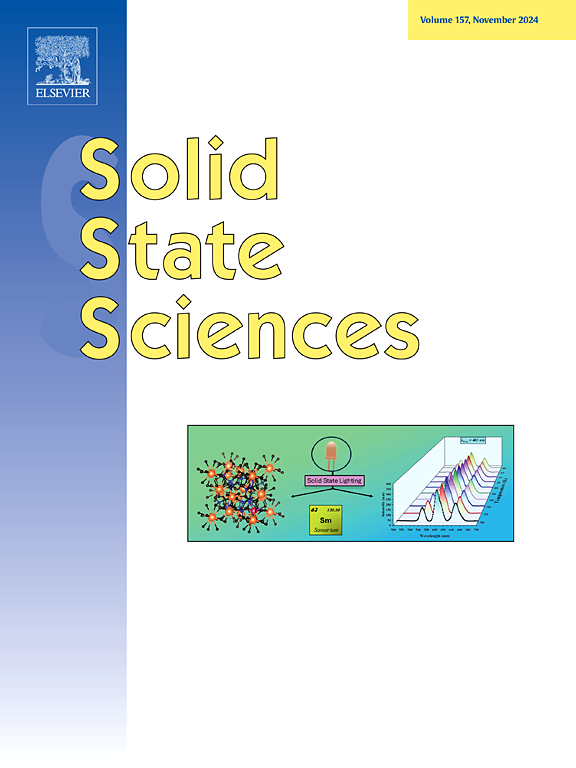Synthesis and characterization of GeNx films with different nitrogen ratios: An experimental and DFT analysis
IF 3.3
3区 化学
Q2 CHEMISTRY, INORGANIC & NUCLEAR
引用次数: 0
Abstract
In this study, GeNx thin films with varying nitrogen ratios (30 %, 50 %, and 70 %) were deposited on sapphire and silicon substrates at room temperature using the RF magnetron sputtering technique. Optical properties of the films deposited on sapphire were characterized using UV–VIS–NIR spectrophotometry, which provided insights into their transmittance and energy band gap values. For films grown on silicon, spectroscopic ellipsometry was employed to determine their refractive indices. The XRD patterns of the films grown on sapphire indicated the presence of the (220) crystallographic plane of GeNx, which became pronounced in the sample produced with 50 % nitrogen content. Notably, the energy band gap of the films varied between 3.40 eV and 4.10 eV, exhibiting a dependence on the nitrogen ratio as it increased from 30 % to 70 %. Similarly, a change in the refractive index values was observed with increasing nitrogen ratio. It was observed that the film with a 30 % nitrogen ratio had the highest refractive index. The mode at ∼303 cm−1 for both films grown on Si and sapphire is well-known TO (c-Ge) vibration. To further support and validate the experimental findings, Density Functional Theory (DFT) calculations were performed to correlate the experimentally determined energy band gaps. It was observed that the experimentally found energy band gap values, especially the 30 % nitrogen film, were very close to γ-Ge3N4 from theoretical calculations. This computational approach enhanced the reliability and consistency of the results.

不同氮比GeNx薄膜的合成与表征:实验与DFT分析
在本研究中,采用射频磁控溅射技术在室温下将不同氮比(30%,50%和70%)的GeNx薄膜沉积在蓝宝石和硅衬底上。利用紫外-可见-近红外分光光度法对沉积在蓝宝石上的薄膜的光学性质进行了表征,得到了薄膜的透光率和能带隙值。对于生长在硅上的薄膜,采用椭偏光谱法测定其折射率。在蓝宝石表面生长的薄膜的XRD谱图表明,在含氮量为50%的样品中,GeNx的(220)晶面明显存在。值得注意的是,薄膜的能带隙在3.40 eV和4.10 eV之间变化,表现出氮含量从30%增加到70%的依赖性。同样,随着氮比的增加,折射率值也发生了变化。结果表明,氮含量为30%时,薄膜的折射率最高。在~ 303 cm−1处生长在Si和蓝宝石上的两种薄膜的模式都是众所周知的TO (c-Ge)振动。为了进一步支持和验证实验结果,进行了密度泛函理论(DFT)计算,以关联实验确定的能带隙。结果表明,实验发现的能带隙值与理论计算的γ-Ge3N4非常接近,特别是30%氮膜。这种计算方法提高了计算结果的可靠性和一致性。
本文章由计算机程序翻译,如有差异,请以英文原文为准。
求助全文
约1分钟内获得全文
求助全文
来源期刊

Solid State Sciences
化学-无机化学与核化学
CiteScore
6.60
自引率
2.90%
发文量
214
审稿时长
27 days
期刊介绍:
Solid State Sciences is the journal for researchers from the broad solid state chemistry and physics community. It publishes key articles on all aspects of solid state synthesis, structure-property relationships, theory and functionalities, in relation with experiments.
Key topics for stand-alone papers and special issues:
-Novel ways of synthesis, inorganic functional materials, including porous and glassy materials, hybrid organic-inorganic compounds and nanomaterials
-Physical properties, emphasizing but not limited to the electrical, magnetical and optical features
-Materials related to information technology and energy and environmental sciences.
The journal publishes feature articles from experts in the field upon invitation.
Solid State Sciences - your gateway to energy-related materials.
 求助内容:
求助内容: 应助结果提醒方式:
应助结果提醒方式:


